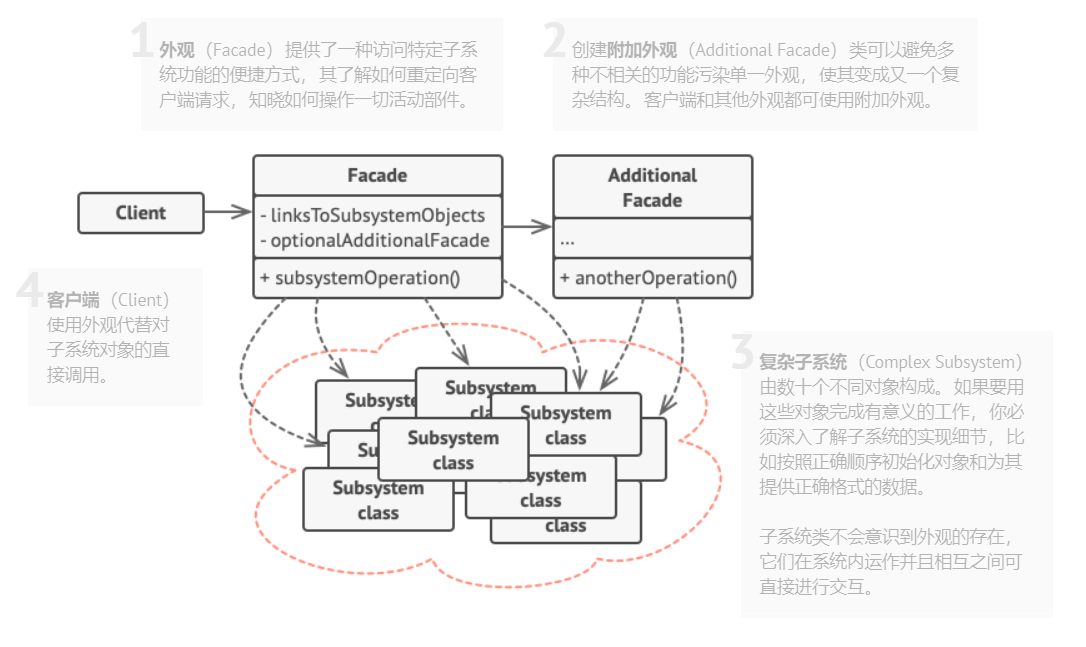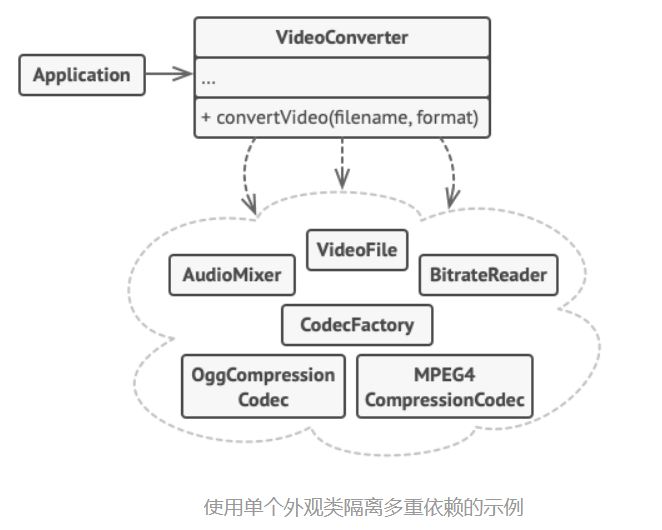Facade
外观模式(门面模式)是一种结构型设计模式, 能为程序库、 框架或其他复杂类提供一个简单的接口。
外观模式结构

核心 Java 程序库中的外观示例:
- javax.faces.context.FacesContext 在底层使用了 LifeCycle、ViewHandler 和 NavigationHandler 这几个类, 但绝大多数客户端不知道。
- javax.faces.context.ExternalContext 在内部使用了 ServletContext、HttpSession、 HttpServletRequest、 HttpServletResponse 和其他一些类。
识别方法: 外观可以通过使用简单接口, 但将绝大部分工作委派给其他类的类来识别。 通常情况下, 外观管理着其所使用的对象的完整生命周期。
样例

// 这里有复杂第三方视频转换框架中的一些类。我们不知晓其中的代码,因此无法
// 对其进行简化。
class VideoFile
// ...
class OggCompressionCodec
// ...
class MPEG4CompressionCodec
// ...
class CodecFactory
// ...
class BitrateReader
// ...
class AudioMixer
// ...
// 为了将框架的复杂性隐藏在一个简单接口背后,我们创建了一个外观类。它是在
// 功能性和简洁性之间做出的权衡。
class VideoConverter is
method convert(filename, format):File is
file = new VideoFile(filename)
sourceCodec = new CodecFactory.extract(file)
if (format == "mp4")
destinationCodec = new MPEG4CompressionCodec()
else
destinationCodec = new OggCompressionCodec()
buffer = BitrateReader.read(filename, sourceCodec)
result = BitrateReader.convert(buffer, destinationCodec)
result = (new AudioMixer()).fix(result)
return new File(result)
// 应用程序的类并不依赖于复杂框架中成千上万的类。同样,如果你决定更换框架,
// 那只需重写外观类即可。
class Application is
method main() is
convertor = new VideoConverter()
mp4 = convertor.convert("funny-cats-video.ogg", "mp4")
mp4.save()
外观模式优点
- 降低了子系统与客户端之间的耦合度,使得子系统的变化不会影响调用它的客户类。
- 对客户屏蔽了子系统组件,减少了客户处理的对象数目,并使得子系统使用起来更加容易。
- 降低了大型软件系统中的编译依赖性,简化了系统在不同平台之间的移植过程,因为编译一个子系统不会影响其他的子系统,也不会影响外观对象。
外观模式缺点
- 不能很好地限制客户使用子系统类,很容易带来未知风险。
- 增加新的子系统可能需要修改外观类或客户端的源代码,违背了“开闭原则”。


